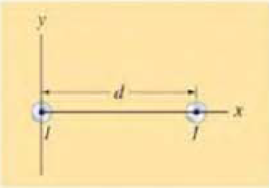
Concept explainers
(II) Repeat Problem 19 if the wire at x = 0 carries twice the current (2I) as the other wire, and in the opposite direction.
19. (II) Let two long parallel wires, a distance d apart, carry equal currents I in the same direction. One wire is at x = 0, the other at x = d, Fig. 28–38. Determine
FIGURE 28–38 Problems 19 and 20.

Want to see the full answer?
Check out a sample textbook solution
Chapter 28 Solutions
Physics for Scientists and Engineers with Modern Physics
Additional Science Textbook Solutions
Physics for Scientists and Engineers: A Strategic Approach with Modern Physics (4th Edition)
The Cosmic Perspective (8th Edition)
An Introduction to Thermal Physics
University Physics (14th Edition)
College Physics: A Strategic Approach (3rd Edition)
Lecture- Tutorials for Introductory Astronomy
- Hall potentials are much larger for poor conductors than for good conductors. Why?arrow_forwardHow can you decide if a wire is infinite?arrow_forwardReview. The use of superconductors has been proposed for power transmission lines. A single coaxial cable (Fig. P31.47) could carry a power of 1.00 103 MW (the output of a large power plant) at 200 kV, DC, over a distance of 1.00 103 km without loss. An inner wire of radius a = 2.00 cm, made from the superconductor Nb3Sn, carries the current I in one direction. A surrounding superconducting cylinder of radius b = 5.00 cm would carry the return current I. In such a system, what is the magnetic field (a) at the surface of the inner conductor and (b) at the inner surface of the outer conductor? (c) How much energy would he stored in the magnetic field in the space between the conductors in a 1.00 103 km superconducting line? (d) What is the pressure exerted on the outer conductor due to the current in the inner conductor? Figure P31.47arrow_forward
- The density of charge carriers far copper is 8.471028 electrons per cubic meter. What will be the Hall voltage reading from a probe made up of 3cm2cm1cm ( (LWT) ) copper plate when a current of 1.5 A is passed through it in a magnetic field of 2.5 T perpendicular to the 3cm2cm .arrow_forward(II) Two long straight wires each carry a current I out of the page toward the viewer, Fig. 20–56. Indicate, with appropriate arrows, the direc- tion of B at each of the points 1 to 6 in the plane of the page. State if the field is zero at any of the points. I • 4 • 2 • 5 3 FIGURE 20-56 Problem 37. 10 • 6arrow_forward(14) Four very long straight parallel wires, located at the corners of a square of side l, carry equal currents Io perpendicular to the page as shown in figure. Determine the magnitude and direction of B at the center of the square. 3 4arrow_forward
- 31. (II) A rectangular loop of wire is placed next to a straight wire, as shown in Fig. 20-55. There is a current of 3.5 A in both wires. Deter- 3.5 A 23 mine the magnitude and direction of the net force on the loop. FIGURE 20-55 Problem 31. 5.0 cm 3.5 A 10.0 cm- 3.0 cmarrow_forward8 Figure 29-31 shows four arrangements in which long, parallel, equally spaced wires carry equal currents directly into or out of the page. Rank the arrangements according to the magnitude of the net force on the central wire due to the currents in the other wires, greatest first. (a) (b) (c) (d)arrow_forward(a) — (b) — (c) O O Od>c>b> a Ob>d>a> c (d) — Ø The figure shows four arrangements in which long, parallel, equally spaced wires carry equal currents directly into or out of the page. Rank the arrangements according to the magnitude of the net force on the central wire due to the currents in the other wires, greatest first. Od>b>c> a Ob>a>c>d Ob>d>c> a & Ⓡ Ⓡ Oarrow_forward
- If an electric current of 8A is split into three branches, forming a parallel combination, and the lengths of the wires in these branches are in the ratio 3:4:5, while their diameters are in the ratio 2:3:4, then what is the current flowing through first branch? Assume that all the wires are made of the same material. A) 448 A OB) 0.60 A OC) 1.54 A OD) 2.50 A OE) 7.90 A A erabakarrow_forward12. (I) Find the direction of the force on a negative charge for each diagram shown in Fig. 20-52, where v (green) is the velocity of the charge and B (blue) is the direction of the magnetic field. ( means the vector points inward. O means it points outward, toward you.) (a) B FIGURE 20-52 Problem 12. V B (b) (c) B V B B (d) P₁ (f)arrow_forward(c) Two long, parallel wires are separated by a distance of 2.5 cm. The force per unit length that each wire exerts on the other is 4×10−5 N/m, and the wires repel each other. The current in one wire is 0.60 A. Determine the magnitude and direction of the current flowing in the second wire.arrow_forward

 Physics for Scientists and Engineers: Foundations...PhysicsISBN:9781133939146Author:Katz, Debora M.Publisher:Cengage Learning
Physics for Scientists and Engineers: Foundations...PhysicsISBN:9781133939146Author:Katz, Debora M.Publisher:Cengage Learning Physics for Scientists and EngineersPhysicsISBN:9781337553278Author:Raymond A. Serway, John W. JewettPublisher:Cengage Learning
Physics for Scientists and EngineersPhysicsISBN:9781337553278Author:Raymond A. Serway, John W. JewettPublisher:Cengage Learning Physics for Scientists and Engineers with Modern ...PhysicsISBN:9781337553292Author:Raymond A. Serway, John W. JewettPublisher:Cengage Learning
Physics for Scientists and Engineers with Modern ...PhysicsISBN:9781337553292Author:Raymond A. Serway, John W. JewettPublisher:Cengage Learning Glencoe Physics: Principles and Problems, Student...PhysicsISBN:9780078807213Author:Paul W. ZitzewitzPublisher:Glencoe/McGraw-Hill
Glencoe Physics: Principles and Problems, Student...PhysicsISBN:9780078807213Author:Paul W. ZitzewitzPublisher:Glencoe/McGraw-Hill Principles of Physics: A Calculus-Based TextPhysicsISBN:9781133104261Author:Raymond A. Serway, John W. JewettPublisher:Cengage Learning
Principles of Physics: A Calculus-Based TextPhysicsISBN:9781133104261Author:Raymond A. Serway, John W. JewettPublisher:Cengage Learning





